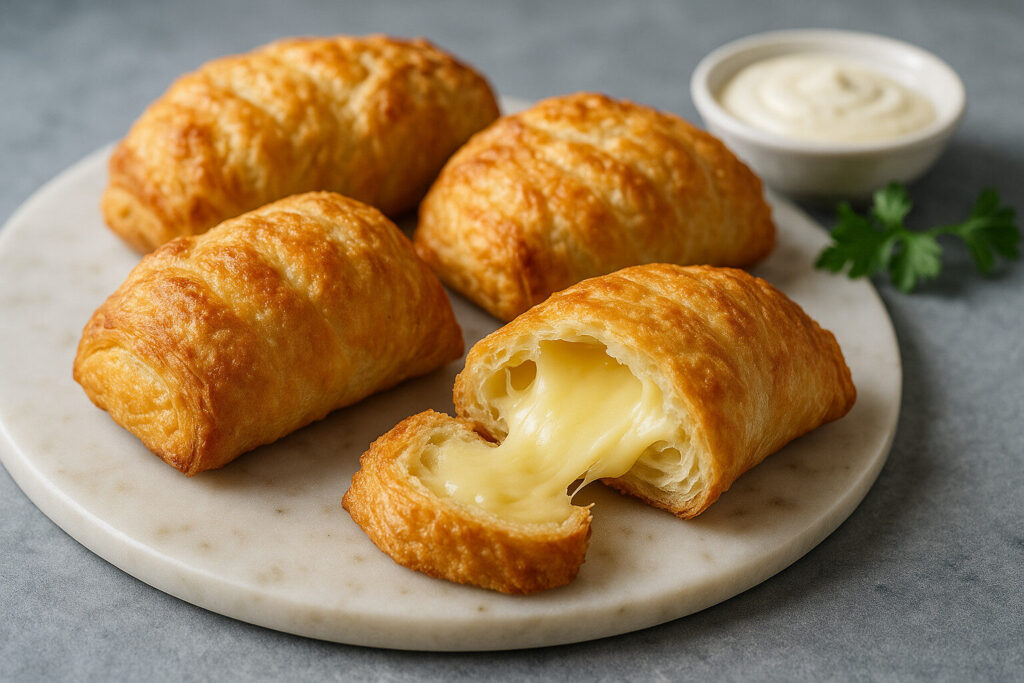
Cheese and pastry form one of the strongest culinary partnerships. The fat and moisture of cheese contrast with the crispness of dough, creating snacks and meals that range from rustic to refined. From Balkan börek and Middle Eastern fatayer to French quiche and Austrian strudel, cheese has been baked into doughs for centuries. The variety of cheese types used — soft, crumbly, stretchy, aged — changes texture and flavor dramatically. Understanding which cheeses belong in which pastry ensures that the balance of crisp outside and creamy inside works every time.
In this article
Cheese and Pastry Across Cultures
- Mediterranean and Middle Eastern traditions: Feta, halloumi, akkawi, or nabulsi cheese are common in börek, pies, and filled breads. These cheeses crumble well, stay firm under heat, and balance rich, oily doughs.
- Central and Eastern Europe: Bryndza, quark, or tvorog form the base of many savory strudels or dumpling-like pastries. Their mild acidity offsets buttery dough.
- Western Europe: France has elevated cheese pastry into haute cuisine with quiches, gougères (cheese puffs with Gruyère), and cheese croissants. Gruyère, Comté, and Emmental are dominant here.
- Modern baking: Cream cheese dominates cheesecakes, Danish pastries, and roulades, offering smoothness and adaptability.
Cheese in pastry reflects regional availability. Salty, firm cheeses suit hot climates; soft, fresh cheeses thrive in cooler regions with refrigeration.
Comparative Cheese Table (Pastry Context)
| Cheese Type | Texture & Bake Behavior | Flavor Profile | Typical Pastry Uses | Cost (approx.) |
|---|---|---|---|---|
| Feta | Crumbly, stays firm | Salty, tangy | Börek, spanakopita, pies | Medium |
| Bryndza/Quark | Creamy, slightly sour | Mild, tangy | Strudel, pierogi, savory tarts | Medium |
| Gruyère | Melts, browns well | Nutty, sharp | Gougères, quiche Lorraine | High |
| Emmental/Comté | Smooth melt | Mild, nutty | Quiches, croissants, puffs | Medium–high |
| Cream Cheese | Smooth, spreadable | Mild, buttery | Danish pastry, cheesecake | Medium |
| Ricotta | Moist, light | Mild, creamy | Cannoli, pies, calzones | Medium |
| Halloumi | Firm, chewy | Salty, savory | Baked pockets, börek | Medium–high |
| Blue Cheese | Crumbly, melts partly | Pungent, salty | Puff pastry bites, strudel | Medium–high |
| Taleggio | Creamy, intense | Earthy, aromatic | Gourmet tarts, flat pastries | High |
Neutral and Intense Cheeses in Pastries
Neutral cheeses such as ricotta, quark, or cream cheese form the body of many fillings. They create moisture and softness, often mixed with eggs and herbs. Intense cheeses — feta, Gruyère, blue, taleggio — act as flavor drivers, often used in smaller amounts to give sharpness and aroma. Successful pastry fillings often combine both: one cheese for texture, one for character.
Examples of Cheese in Pastry
Börek and Spanakopita
Thin filo dough encases salty cheeses like feta or halloumi, sometimes mixed with spinach or herbs. The saltiness contrasts with the flaky pastry and creates a rich but balanced bite.
Quiche Lorraine
A custard of eggs and cream holds Gruyère or Emmental. These cheeses melt smoothly, binding the filling while browning lightly on top. Their nutty flavors stand up to bacon or ham.
Gougères
Classic French choux pastries enriched with Gruyère or Comté. The cheese is grated into the dough itself, producing airy, savory puffs with sharp aroma.
Strudel and Eastern Pastries
Quark or bryndza mixed with herbs or onions fills stretched dough, then bakes into savory rolls. Their mild acidity lightens the heaviness of the buttery crust.
Modern Pastries
Cream cheese creates rich Danish pastries, cheesecakes, and roulades. Taleggio or blue cheese folded into puff pastry adds gourmet character, often served as small appetizers.
Exquisite Pastry Cheeses
Some cheeses transform pastries into fine dining. Taleggio’s earthy creaminess elevates rustic tarts. Blue cheese in puff pastry, paired with pear or fig, creates elegant contrasts. Smoked scamorza or provolone give rustic aroma in calzones or stromboli. Even burrata can appear in modern deconstructed pastry dishes, though it must be served quickly due to its moisture.
Pairings and Serving
Cheese pastries rarely stand alone. They are complemented by:
- Fresh herbs (dill, parsley, thyme) to cut richness.
- Vegetables (spinach, onion, mushroom) that pair with saltier cheeses.
- Fruits (pear, fig, apricot) that balance strong cheeses in sweet-savory pastries.
- Wines: white wines with acidity (Sauvignon Blanc, Riesling) match quiche, while dessert wines pair with blue cheese pastries.
Price and Nutrition Comparison (per 100 g, average values)
| Cheese Type | Avg. Price €/kg | kcal | Protein (g) | Fat (g) | Salt (g) |
|---|---|---|---|---|---|
| Feta | 12–16 | 260 | 14 | 21 | 2.8 |
| Bryndza/Quark | 8–12 | 150 | 12 | 10 | 0.8 |
| Gruyère | 20–26 | 413 | 30 | 32 | 1.6 |
| Emmental/Comté | 16–22 | 380 | 29 | 28 | 1.5 |
| Cream Cheese | 8–12 | 250 | 6 | 24 | 1.0 |
| Ricotta | 8–12 | 170 | 11 | 13 | 0.2 |
| Halloumi | 14–18 | 320 | 22 | 26 | 2.5 |
| Blue Cheese | 16–20 | 350 | 21 | 29 | 3.0 |
| Taleggio | 18–22 | 360 | 20 | 29 | 2.0 |
(Values are approximate averages. Prices and nutrition vary by region and producer.)
Conclusion
Cheese in pastry is about balance between texture and intensity. Neutral cheeses provide creaminess, intense ones add signature aroma. Regional traditions — from feta in filo to Gruyère in quiche — show how local cheeses shape pastry identity. Modern chefs expand this further with blue cheese, taleggio, or smoked varieties in puff pastry or strudel. Whether rustic street food or gourmet canapé, cheese-filled pastries demonstrate how simple dough and cheese together can achieve complex, satisfying results.
